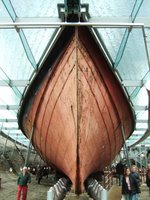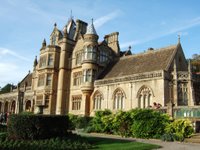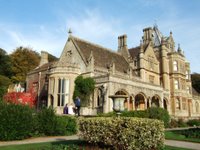 To complete our alliterative month: Bellingham; Baldock; and Birmingham, we set off for Bristol. Saturday's highlight was a visit to the SS Great Britain. This ship, designed by the famous engineer Brunel, was launched in 1843. It was the first ship to be made of iron, the first to use a propeller instead of paddle-wheels, the first with a balanced rudder, in fact the largest and most technically innovative ship at that time.
To complete our alliterative month: Bellingham; Baldock; and Birmingham, we set off for Bristol. Saturday's highlight was a visit to the SS Great Britain. This ship, designed by the famous engineer Brunel, was launched in 1843. It was the first ship to be made of iron, the first to use a propeller instead of paddle-wheels, the first with a balanced rudder, in fact the largest and most technically innovative ship at that time.  After a long and eventful life it was, in 1970, rescued from the seabed in the Falklands, and brought back to Bristol and is now on display in the dry-dock where it was originally built. Given that the typical life for a ship at that time was 20 years, it is truly remarkable that, 160 years later, we can still go aboard.
After a long and eventful life it was, in 1970, rescued from the seabed in the Falklands, and brought back to Bristol and is now on display in the dry-dock where it was originally built. Given that the typical life for a ship at that time was 20 years, it is truly remarkable that, 160 years later, we can still go aboard.It is an excellent exhibition: Not only can you take a tour of the ship and see the cabins and saloons, reconstructed, as they originally were, you can tour the kitchens, sailor’s quarters and engine room.
 But just as interesting is the chance to walk on the bed of the dry dock, and view the hull of the ship, the state-of-the-art balanced rudder and the revolutionary propeller, all under a glass sea. This glass sea is hermetically sealed and the humidity below the water line is kept below 20% RH as this is, apparently, the only way to halt the process of corrosion.
But just as interesting is the chance to walk on the bed of the dry dock, and view the hull of the ship, the state-of-the-art balanced rudder and the revolutionary propeller, all under a glass sea. This glass sea is hermetically sealed and the humidity below the water line is kept below 20% RH as this is, apparently, the only way to halt the process of corrosion.Our other visit of the day was to see the coral reef at the Wildwalk exhibition. This complex is a great place to take the family on a wet day, but sadly the walk-though coral reef, billed as the first in Europe, was not worth the entrance price. We finished the wet day at the Industrial History Museum, also on the waterfront.
It is one of the interesting facets of visiting places in the UK is that some labels take on a whole new meaning. What are simply ‘Southdown’ or ‘Romney’ sheep, ‘Jersey’ cows or ‘Ayrshire’ bulls back home in NZ, take on a whole new dimension when you walk the South Downs or drive through the Romney Marshes or Ayrshire. Similarly one does not think of the sturdy old Bristol Freighter, a common site from my youth, as coming from Bristol, it is just a name. So, it was interesting to see the display on the history of Bristol aircraft, to see old Bristol cars etc at the Bristol Industrial History Museum.

Sunday was a beautiful day. After a circular walk that returned along the coastal path to Clevedon, we went to have a look at Tyntesfield. This linked neatly into our tour of the SS Great Britain the previous day as Tyntesfield belonged to the Gibbs family, who purchased the ship in 1850 and used it as a passenger ship to Australia. The Gibbs family were just merchants and traders until one of their agents signed an exclusive deal to ship guano in from South America, making them extremely wealthy almost overnight. As one contemporary (and probably envious) commentator said, “...[they] got rich from the turds of birds.”
 The house is large and impressive. The NT only purchased it recently and restoration work is still in early stages. When Richard Gibbs, the last Gibbs to live there, died in 2001 his will decreed that house and contents be sold and the proceeds distributed to 19 nieces, nephews, cousins etc as his younger brother had indicated he did not want to inherit the stately pile.
The house is large and impressive. The NT only purchased it recently and restoration work is still in early stages. When Richard Gibbs, the last Gibbs to live there, died in 2001 his will decreed that house and contents be sold and the proceeds distributed to 19 nieces, nephews, cousins etc as his younger brother had indicated he did not want to inherit the stately pile.  The National Trust launched a public campaign to raise money to buy it - and to prevent Kylie Minogue or Madonna from doing so. With a rather large grant from the National Heritage Memorial Fund the NT closed a deal after a 26 hour meeting with the executors and agents.
The National Trust launched a public campaign to raise money to buy it - and to prevent Kylie Minogue or Madonna from doing so. With a rather large grant from the National Heritage Memorial Fund the NT closed a deal after a 26 hour meeting with the executors and agents.  One interesting condition of the NHMF grant was that the NT had to open the doors to the public within 10 weeks of getting the keys. This shortened the usual NT opening timescale by about 8 years and enabled us to visit.
One interesting condition of the NHMF grant was that the NT had to open the doors to the public within 10 weeks of getting the keys. This shortened the usual NT opening timescale by about 8 years and enabled us to visit.




No comments:
Post a Comment